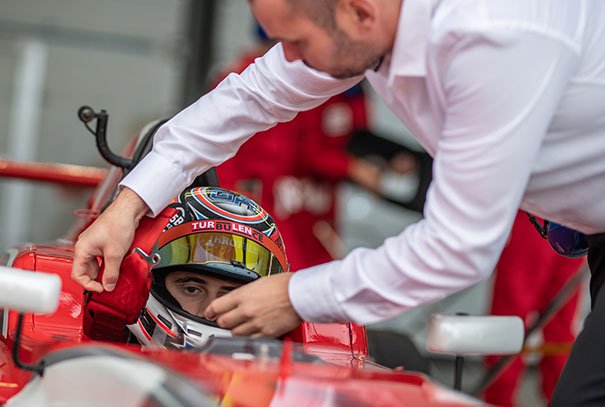An analysis of the most pressing concerns based on insights from 1,000 UK business leaders.

Over the decades, professional motorsport has made massive progress and improvements to safety, from karting through to Formula 11. Regulatory bodies such as the FIA, FIM and The Motorsports Council are committed to ensuring safety for drivers, teams and spectators.
Across the different sectors of the sport, the chances of an accident resulting in serious injury vary dramatically. Cars, karts and bikes are being pushed to their limits, and safety measures are dependent on the type of vehicle and race setting, from road races to custom-built tracks.
Key Formula 1 safety advancements
Formula 1’s attitudes to safety were transformed for good following significant events in 1994 and 2014. An ongoing commitment to continual improvement was made and the importance of safety was firmly established .
Safety reviews over the last 10 years have led to a series of increasingly prescriptive measures that have contributed to the sport’s safety, including:3,4
Driver protection: Modern carbon fibre, Kevlar and polythene helmets are fire resistant and can withstand serious impact. Biometric gloves, introduced in 2018, have sensors that send information on pulse and oxygen levels to race control. Mandatory tougher safety standards for driver clothing introduced in 2020 include fireproof overalls, underwear, socks and balaclava.
Car reinforcement: Head and neck support (Hans) was made compulsory in 2003. Introduced in 2018, the Halo, a three-part titanium bar fitted above the driver’s head, is now confirmed as essential, effective kit. Reinforced fuel tanks and the 2010 ban on refuelling has helped to reduce the risks from in-vehicle and pit lane fires.
Track design: Modern circuits put a premium on safety to protect drivers, marshals and spectators from harm. Wider run-off areas, pit lane speed limits and the rigorous use of the safety car have all contributed to safer events.
How the rest of motorsports is putting safety first
With this emphasis on safety at the highest level of motorsport, other categories have also consistently demonstrated enhanced awareness and practical safety solutions.
Regulation helmets and leather suits are mandatory in karting, establishing a focus and commitment to safety at what is often the entry-level to a career in motorsport.
Hans devices which protect the head and neck are recommended or mandatory in most car categories, with the FIA making their use compulsory for all international-level events since the beginning of 20095.
The introduction of the MotoGP body airbag, which became mandatory for all riders in 2018, gives vital extra protection to riders around the shoulders and upper body. The airbag LED detection system also improves safety for all the riders due to enhanced visibility when racing in poor weather conditions6.
At the 2020 Bahrain Grand Prix an incident involving Romain Grosjean showed just how much motorsport safety had improved. Grosjean’s car split in half and exploded into flames. While the incident was terrifying to see, Grosjean was taken to hospital with only minor burns and broken ribs7.
A stark reminder of how dangerous motorsport can be, the incident was also a testament to just how hard the FIA and F1 have worked to improve safety over recent years8. And with F1 setting the tone for the rest of the industry, and the resulting developments in technology feeding through ultimately to road cars, it has never been safer to be in a car than it is today.
Insuring for optimum safety
The insurance market plays a pivotal role in assisting the motorsport industry with risk management advice. At large, those stakeholders in the motorsport industry who have taken insurance and risk management advice and implemented it into their respective plans to go racing have benefitted. Taking advice from insurance experts helps to assess specific exposures, build fit and proper insurance coverage, and maintain fair premium pricing for the risks covered. It also ensures all those going racing can feel comfortable that they have managed the risk particular to them, and are well protected.
Gallagher motorsports polices are bespoke to each motorsport party, be that Governing bodies, rights holders, circuit owners, teams, drivers and riders. We take pride following many years of experience in ensuring they have the correct solutions and levels of protection. Our dedicated and experienced team evaluate every insurable risk a driver faces, so we find the ideal level of cover, and construct the correct policy wording for each particular situation.
As for emerging risks, when the motorsport industry moves forward into new territories with novel competitions such as e-sports, our team moves with these changes. We are able to arrange coverages pertinent to such risks, such as cyber cover or transmission failure.
Motorsports is continually evolving, and Gallagher will be there to evolve with you, with the express intention to safely protect everyone involved.
Sources:
1. https://www.hagerty.com/media/motorsports/the-danger-story/
2. https://www.thenationalnews.com/sport/formula-one-s-safety-reforms-since-ayrton-senna-and-roland-ratzenberger-deaths-1.241502
3. https://www.intentsgp.com/f1-and-motogp-deaths-how-motorsport-is-now-safer-than-ever/
4. https://www.autosport.com/f1/news/149628/history-of-safety-devices-in-formula-1
5. https://en.wikipedia.org/wiki/HANS_devic
6. https://www.crash.net/motogp/news/937411/1/rossi-biggest-change-race-suits-robocop-airbags
7. https://www.motorsport.com/f1/news/grosjeans-overalls-new-standards-helped-bahrain-crash/4919736/
8. https://www.intentsgp.com/f1-and-motogp-deaths-how-motorsport-is-now-safer-than-ever/




